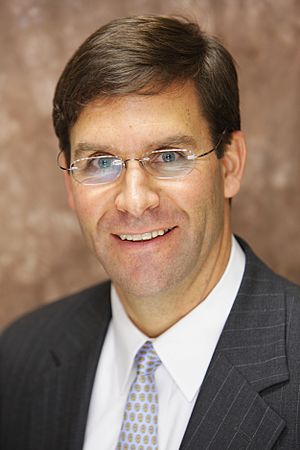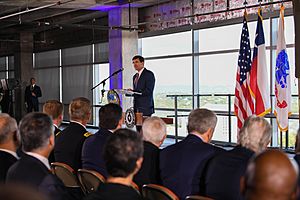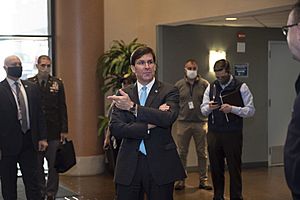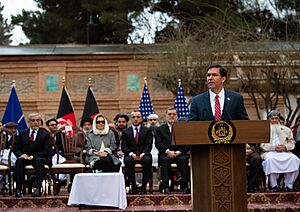Mark Esper facts for kids
Quick facts for kids
Mark Esper
|
|
|---|---|
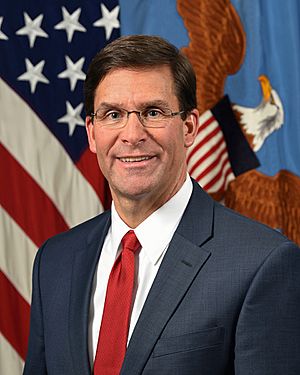
Official portrait, 2019
|
|
| 27th United States Secretary of Defense | |
| In office July 23, 2019 – November 9, 2020 |
|
| President | Donald Trump |
| Deputy | Richard V. Spencer (acting) David Norquist (acting) |
| Preceded by | Jim Mattis |
| Succeeded by | Lloyd Austin |
| Acting June 24, 2019 – July 15, 2019 |
|
| President | Donald Trump |
| Deputy | David Norquist (acting) |
| Preceded by | Patrick M. Shanahan (acting) |
| Succeeded by | Richard V. Spencer (acting) |
| 23rd United States Secretary of the Army | |
| In office November 20, 2017 – July 23, 2019* |
|
| President | Donald Trump |
| Deputy | Ryan McCarthy |
| Preceded by | Ryan McCarthy (acting) |
| Succeeded by | Ryan McCarthy |
| Personal details | |
| Born | April 26, 1964 Uniontown, Pennsylvania, U.S. |
| Political party | Republican |
| Spouse |
Leah Lacy
(m. 1989) |
| Children | 3 |
| Relatives | George Esper (uncle) |
| Education | United States Military Academy (BS) Harvard University (MPA) George Washington University (PhD) |
| Occupation | Business executive, venture capitalist, politician |
| Civilian awards | Department of Defense Medal for Distinguished Public Service (two awards) |
| Signature | |
| Website | https://www.marktesper.com/ |
| Military service | |
| Allegiance | United States |
| Branch/service | United States Army |
| Years of service | 1986–2007 |
| Rank | Lieutenant Colonel |
| Unit |
|
| Commands | B/3-325 Airborne Battalion Combat Team, Vicenza, Italy |
| Battles/wars | Persian Gulf War |
| Military awards |
|
| *McCarthy served in an acting capacity from June 24, 2019 to July 15, 2019, while Esper served as Acting U.S. Secretary of Defense. | |
Mark Thomas Esper (born April 26, 1964) is an American politician and business leader. He served as the 27th United States Secretary of Defense from 2019 to 2020 under President Donald Trump. Before that, he was the 23rd United States Secretary of the Army.
Esper graduated from the West Point and became an officer in the United States Army. He fought in the Gulf War with the famous 101st Airborne Division. After more than 20 years of military service, he retired as a lieutenant colonel.
After his military career, Esper worked in several important jobs. He was a top staff member for U.S. senators and committees in Congress. He also worked for a defense company called Raytheon. In 2017, President Trump chose him to be the Secretary of the Army. Two years later, he became the Secretary of Defense.
Contents
Early Life and Schooling
Mark Esper was born on April 26, 1964, in Uniontown, Pennsylvania. His father's family was from Lebanon. His uncle, George Esper, was a famous journalist who reported on wars.
Esper graduated from Laurel Highlands High School in 1982. He then went to the United States Military Academy at West Point. He studied engineering and graduated in 1986. He was a top student and won an award for his leadership.
Later, he earned a master's degree from Harvard University in 1995. He also earned a doctorate degree from George Washington University in 2008.
Military and Government Career
Serving in the Army
Esper served as an infantry officer in the Army for over ten years. He was part of the 101st Airborne Division during the Gulf War. His unit helped defeat the Iraqi Army. He later commanded a company in Europe.
After leaving active duty, he joined the Army National Guard and the Army Reserve. He earned many awards, including the Bronze Star Medal and the Combat Infantryman Badge.
Working in Washington, D.C.
After his military service, Esper worked for the Heritage Foundation, a research group. He then became a top advisor for several U.S. senators and committees in Congress. He helped shape policies related to the military and foreign relations.
From 2002 to 2004, he worked for President George W. Bush's administration. He was a deputy assistant secretary of defense. Later, he worked for the U.S. Chamber of Commerce and the defense company Raytheon. At Raytheon, he was a lobbyist, which means he talked to government officials about the company's interests.
Secretary of the Army
In 2017, President Donald Trump nominated Esper to be the Secretary of the Army. The U.S. Senate confirmed him, and he was sworn in on November 20, 2017.
As Army Secretary, Esper had three main goals:
- Making the Army ready to fight.
- Modernizing the Army with new equipment and technology.
- Making the Army more efficient.
Improving the Army
Esper worked to make the Army stronger and better prepared for future conflicts. He focused on improving recruiting and training for new soldiers. He also brought back the classic "pinks and greens" uniform from World War II to boost morale.
He started a major reform of basic training for combat soldiers. The training was made longer and more difficult. This helped new soldiers become better at skills like marksmanship and land navigation.
To pay for these improvements, Esper started a process called "Night Court." He and other Army leaders reviewed every program to find savings. They cut or reduced hundreds of programs to free up billions of dollars for the Army's top priorities.
Creating Army Futures Command
In 2018, Esper created the Army Futures Command (AFC). This was the biggest change to the Army's structure in over 40 years. The AFC's job is to modernize the Army by developing new weapons and technology faster.
The AFC focused on six main areas:
- Long-range cannons and rockets
- Next-generation combat vehicles
- Future helicopters and aircraft
- A modern Army network
- Air and missile defense
- Soldier lethality (making soldiers more effective in combat)
Secretary of Defense
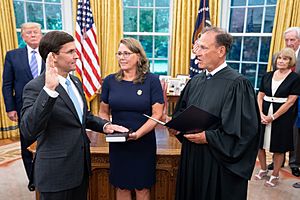
On June 18, 2019, President Trump named Esper the Acting Secretary of Defense. He was officially confirmed by the Senate on July 23, 2019, with a vote of 90–8.
As Secretary of Defense, Esper focused on the National Defense Strategy. This strategy identified China and Russia as the main competitors to the United States. His goal was to make the U.S. military stronger to prevent war.
Leading the Pentagon
Esper made reforms to make the Pentagon more efficient. He used the "Night Court" process he started in the Army to find savings across the entire Department of Defense.
He also worked to strengthen relationships with allies like NATO. He believed in the idea of "peace through strength," which means having a strong military to discourage other countries from starting conflicts.
Major Events During His Term
COVID-19 Pandemic
In 2020, the COVID-19 pandemic became a major crisis. Esper's top priority was protecting military members and their families. The Department of Defense played a big role in the nation's response.
The military sent two Navy hospital ships, the USNS Comfort and USNS Mercy, to help hospitals in New York and Los Angeles. It also provided millions of masks and thousands of ventilators. The Army Corps of Engineers helped build temporary hospitals across the country.
Esper also co-led Operation Warp Speed. This was a government program to help develop a COVID-19 vaccine as quickly as possible. The program was successful, and two vaccines were ready by the end of 2020.
George Floyd Protests
In June 2020, protests took place across the country after the murder of George Floyd. Some protests became destructive. President Trump considered using active-duty military troops to control the unrest.
Esper publicly disagreed with this idea. He said that using active-duty troops for law enforcement should only be a last resort. He believed the National Guard was the right choice for handling domestic issues.
Afghanistan Peace Agreement
In February 2020, the U.S. signed a peace agreement with the Taliban in Afghanistan. The deal called for American troops to withdraw from the country if the Taliban met certain conditions.
Esper supported the agreement but insisted that the withdrawal must be "conditions-based." This meant the U.S. would only pull out its troops if the Taliban kept its promises, such as reducing violence.
Leaving the Pentagon
On November 9, 2020, President Trump announced on Twitter that he had "terminated" Esper. He was replaced by an acting secretary. Esper had already prepared a resignation letter.
Life After the Administration
After leaving his position, Esper wrote a book about his time in the Trump administration. He has also become a fellow at the McCain Institute for International Leadership and a board member for the Atlantic Council. He often appears on news programs to talk about national security issues.
Personal Life
Esper married his wife, Leah, in 1989. They have three children.
Images for kids
-
Esper visits Fort Benning, GA in November 2018 to watch new soldiers train. (U.S. Army photo by Staff Sgt. Nicole Mejia)
-
Esper visited the National Training Center in November 2018.
-
Esper inspects troops in Hanoi, Vietnam, November 20, 2019.
-
Esper with Turkish defense minister Hulusi Akar at NATO headquarters in Brussels, June 2019.
-
Esper (far right), President Donald Trump, and Polish president Andrzej Duda at the White House on June 24, 2020.
-
President Trump walking with his team to St. John's Episcopal Church. Esper is pictured directly behind Trump.
See also
 In Spanish: Mark Esper para niños
In Spanish: Mark Esper para niños


